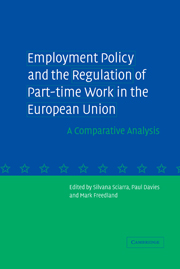Book contents
- Frontmatter
- Contents
- List of figures and tables
- Notes on contributors
- Preface
- List of abbreviations
- PART I
- PART II
- 4 France: part-time work – no longer an employment policy tool
- 5 Germany: part-time work – a bone of contention
- 6 Italy: adaptable employment and private autonomy in the Italian reform of part-time work
- 7 The Netherlands: from atypicality to typicality
- 8 Spain: the difficulty of marrying flexibility with security
- 9 Sweden: part-time work – welfare or unfair?
- 10 The United Kingdom: how is EU governance transformative?
- Index
5 - Germany: part-time work – a bone of contention
Published online by Cambridge University Press: 30 July 2009
- Frontmatter
- Contents
- List of figures and tables
- Notes on contributors
- Preface
- List of abbreviations
- PART I
- PART II
- 4 France: part-time work – no longer an employment policy tool
- 5 Germany: part-time work – a bone of contention
- 6 Italy: adaptable employment and private autonomy in the Italian reform of part-time work
- 7 The Netherlands: from atypicality to typicality
- 8 Spain: the difficulty of marrying flexibility with security
- 9 Sweden: part-time work – welfare or unfair?
- 10 The United Kingdom: how is EU governance transformative?
- Index
Summary
Statistical data
The proportion of part-time to full-time employees
In 1973 the proportion of part-time employees among the total number of employees was 10.1 per cent, which increased in 1983 to 12.6 per cent, and to 18 per cent in 1998. In 2001 there were 6.8 million part-time jobs out of 36.6 million employees, or 18.4 per cent.
Categorisation by occupation
The categorisation of part-time employees into different types of occupation differs substantially between men and women. In the case of women, the largest proportion of part-time employment is in the area of services with a share of around 24 per cent, while in that of men it is in professional activities (lawyers, tax advisers, accountants, etc.) with a share of over 20 per cent. For women this is followed by office workers and technicians with a share of 20 per cent each, and for men by so-called ‘unskilled labour’ with a share of around 20 per cent and technicians with a share of around 14 per cent. Part-time work plays no role in agriculture. These figures are based on the year 1996.
Division of part-time work by gender
For a long time it has been the general rule in the Federal Republic of Germany that part-time work is women's work. A distinction must nevertheless be drawn in this regard between developments in the Länder of the former West Germany and in those of the ex-GDR.
- Type
- Chapter
- Information
- Employment Policy and the Regulation of Part-time Work in the European UnionA Comparative Analysis, pp. 121 - 155Publisher: Cambridge University PressPrint publication year: 2004
- 1
- Cited by

